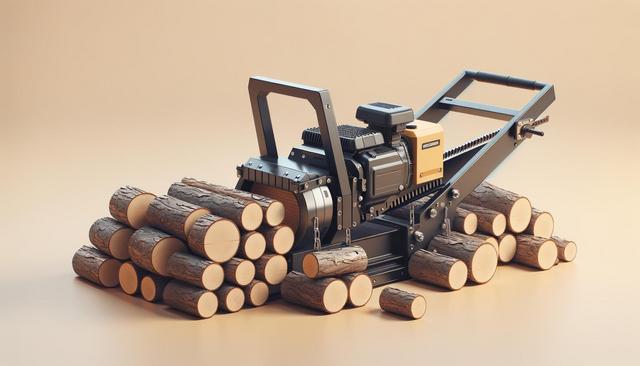Understanding the Purpose of a Heavy Duty Log Splitter
For anyone relying on firewood as a primary or supplemental heat source, investing in a heavy duty log splitter can be a game-changer. These machines are designed to handle large volumes of wood efficiently, saving both time and physical strain. Unlike manual methods such as using an axe or maul, a heavy duty log splitter uses hydraulic or kinetic force to split logs quickly and consistently. This makes it particularly useful for those who manage large properties, operate small farms, or simply want to stockpile firewood for the winter.
Heavy duty log splitters are built to process hardwoods like oak, maple, and hickory, which are often more difficult to split. The benefits of these machines include:
- Increased productivity and reduced manual labor
- Consistent log sizes for easier stacking and burning
- Improved safety compared to hand tools
Whether you’re preparing wood for a fireplace, stove, or outdoor fire pit, a quality log splitter ensures you have the right size and quantity of logs on hand.
Key Features to Look for in a Heavy Duty Log Splitter
When selecting a heavy duty log splitter, it’s important to consider features that match your intended usage. Not all log splitters are made equal, and the right machine depends on your specific needs. One of the first things to look at is the tonnage rating, which indicates how much force the splitter can apply. For heavy-duty tasks, models with 20 to 35 tons of splitting force are typically suitable.
Other essential features include:
- Cycle time: Faster cycle times mean quicker operation.
- Horizontal vs. vertical operation: Vertical splitters are ideal for handling large, heavy logs.
- Engine type: Gas-powered splitters offer more power and mobility compared to electric models.
- Portability: Some log splitters come with wheels and a trailer hitch for easier transport.
Durability is another factor to consider. A machine constructed with high-grade steel and quality components will last longer and perform better under pressure.
Types of Log Splitters Suitable for Heavy Duty Use
There are several types of log splitters available on the market, each with its own strengths. For heavy-duty applications, the focus usually falls on three main types: hydraulic, kinetic, and manual hydraulic splitters. Hydraulic log splitters are the most common and use fluid pressure to drive the ram that splits the log. They are reliable and powerful, with models available in both gas and electric versions.
Kinetic log splitters use flywheels to store energy and release it rapidly, allowing for faster cycle times. They are efficient and require less maintenance but may be more expensive. Manual hydraulic splitters, while not as fast or powerful, can still be suitable for those who need a portable and economical solution for lighter heavy-duty tasks.
Each type has its pros and cons, and the right choice depends on factors such as:
- Volume of wood to be split
- Log size and wood hardness
- Frequency of use
- Available storage space and transportation requirements
Understanding these differences can help you make an informed decision that aligns with your firewood preparation needs.
Maintenance Tips for Long-Term Performance
Maintaining a heavy duty log splitter is essential for ensuring it continues to perform reliably over time. Routine maintenance can prevent downtime and extend the life of the machine. The most common areas that require attention include the engine, hydraulic system, and moving parts. For gas-powered models, regular oil changes and air filter replacements are key to optimal performance.
Other maintenance practices include:
- Checking and topping off hydraulic fluid levels
- Inspecting hoses and seals for leaks or wear
- Sharpening or replacing the splitting wedge as needed
- Cleaning debris from moving parts to prevent buildup
Before storing the splitter for extended periods, it’s a good idea to drain fuel or add stabilizer, lubricate exposed parts, and cover the unit to protect it from the elements. A well-maintained log splitter not only performs better but also ensures safer operation for the user.
Is a Heavy Duty Log Splitter Right for You?
Before purchasing a heavy duty log splitter, it’s important to assess your specific requirements. If you regularly split large volumes of firewood or deal with particularly dense hardwoods, the investment can save you significant time and energy in the long run. However, for occasional users or those with limited space, a smaller or less powerful model might be more appropriate.
Here are a few questions to help determine suitability:
- How often do you split firewood?
- What types and sizes of wood do you typically handle?
- Do you have the space to store and operate a large machine?
- What is your budget for this kind of equipment?
Many users find that a heavy duty option pays for itself over time, especially when compared to the cost and effort of manually splitting wood or buying pre-cut firewood. Understanding your needs and comparing available models accordingly will help you find a log splitter that fits your situation well.
Conclusion: Making Firewood Preparation More Efficient
For those who rely on firewood for heating or outdoor activities, a heavy duty log splitter offers a practical and efficient solution. It not only reduces physical strain but also streamlines the entire process of preparing firewood. By choosing a model that matches your workload and maintaining it properly, you can enjoy years of reliable service. Whether you’re managing a large rural property or simply preparing for winter, a heavy duty log splitter can make your firewood tasks more manageable and less time-consuming.






